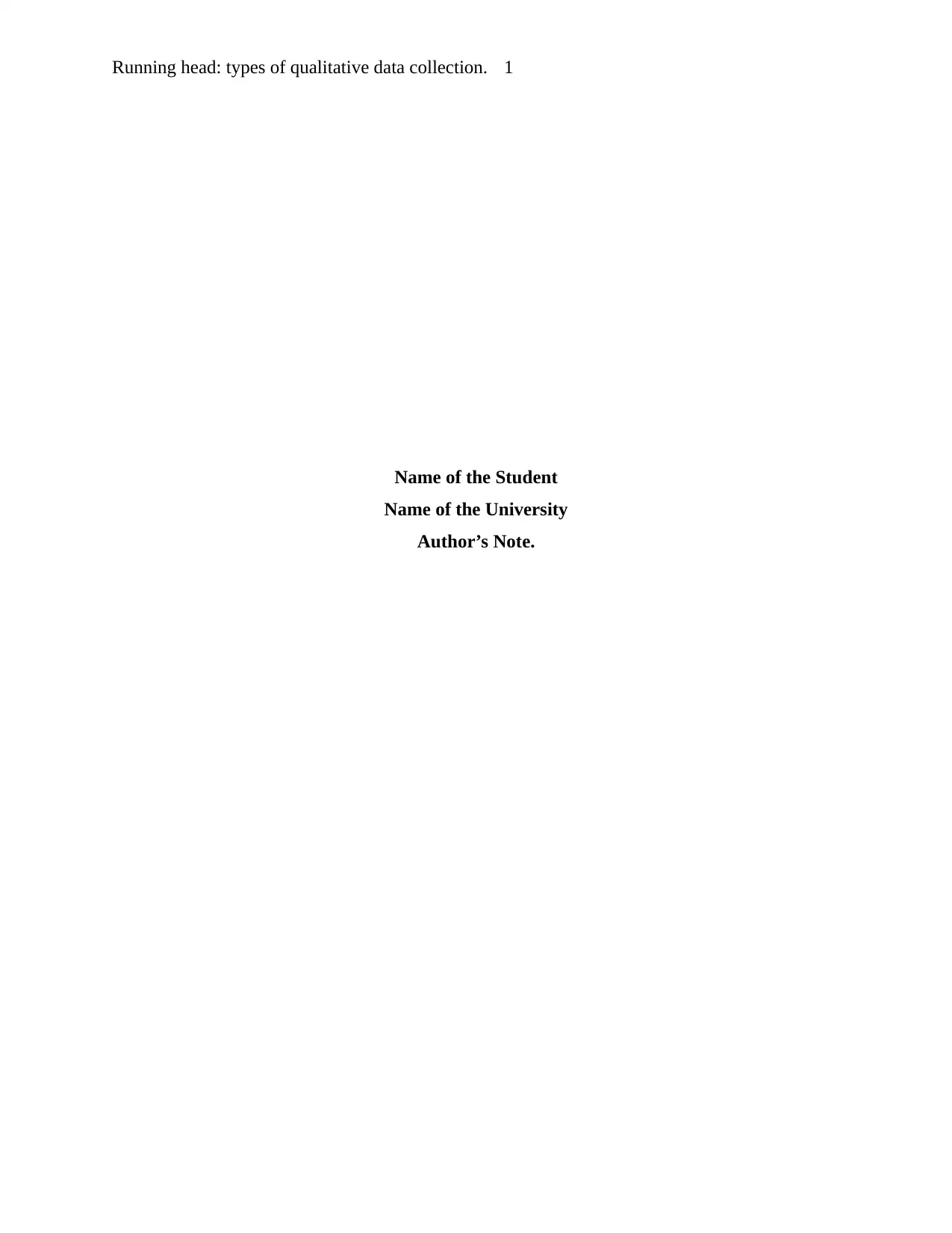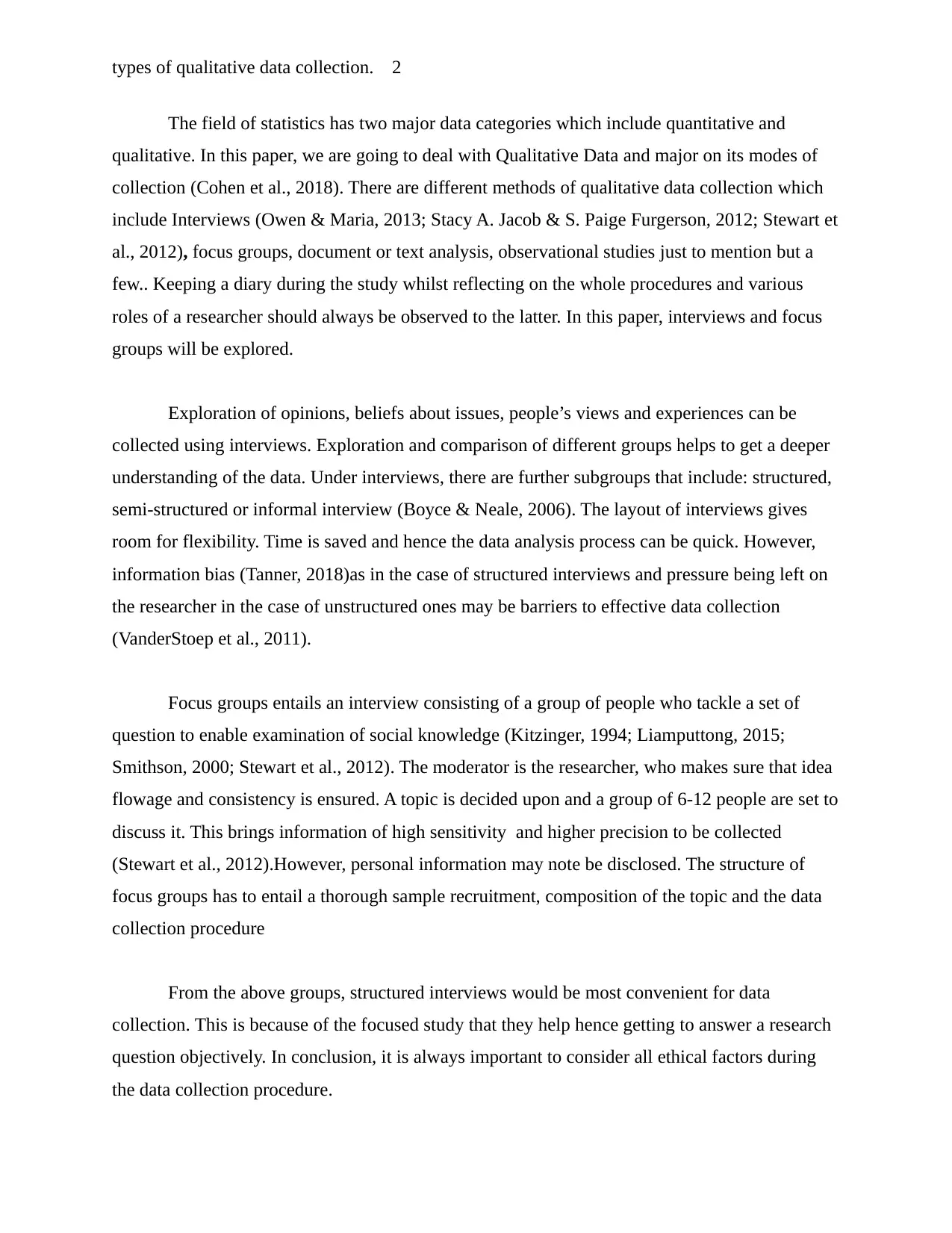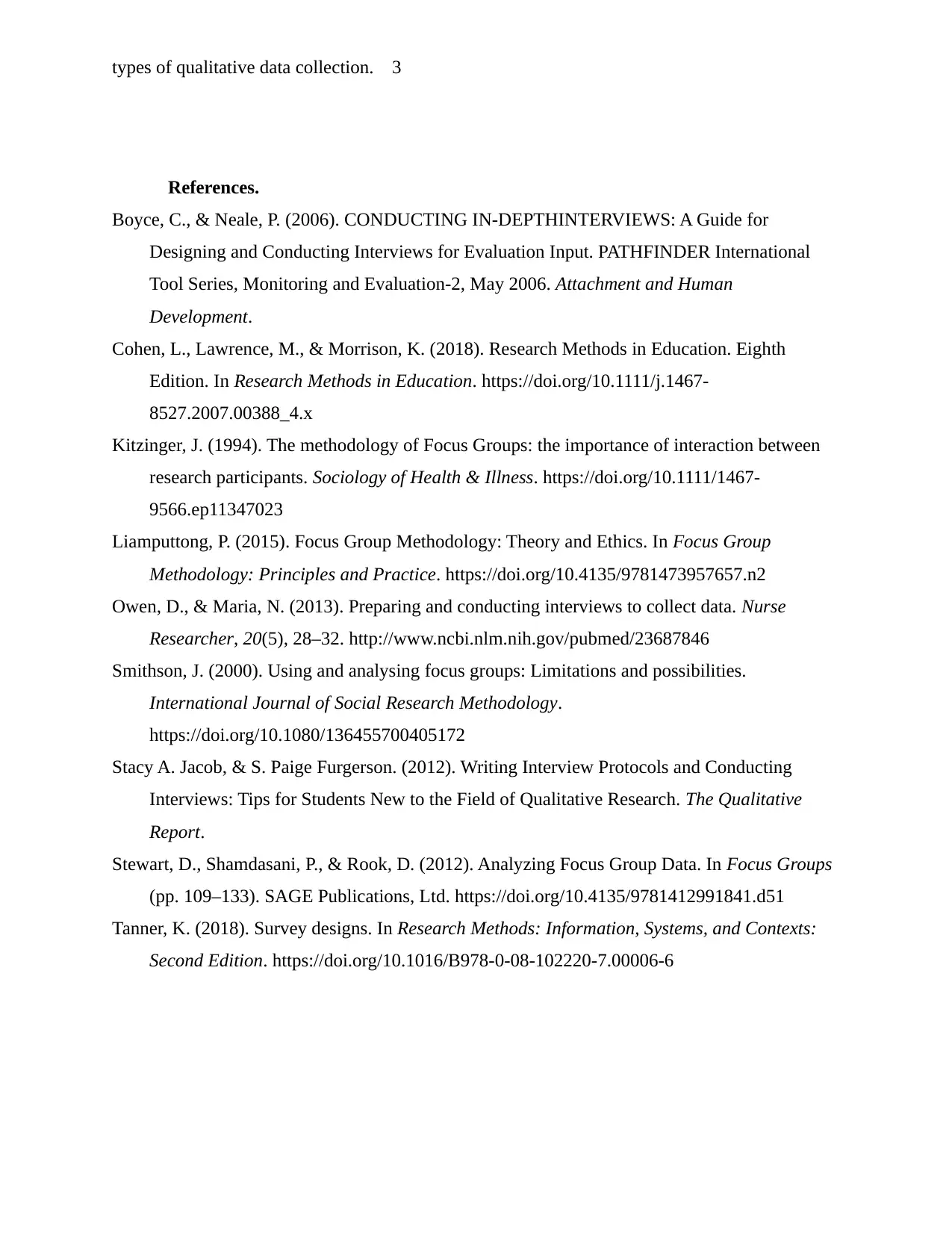University Assignment: Discussing Types of Qualitative Data Collection
VerifiedAdded on 2022/09/09
|4
|759
|17
Discussion Board Post
AI Summary
This discussion post examines two key qualitative data collection methods: interviews and focus groups. The author explores the different types of interviews, including structured and informal, and their respective advantages and disadvantages, such as the control and efficiency of structured interviews versus the flexibility of informal ones, while acknowledging potential biases. The post also delves into focus groups, highlighting their ability to gather in-depth information through group interaction, while also considering potential limitations. The author concludes by emphasizing the importance of ethical considerations throughout the data collection process. The assignment adheres to scholarly writing and APA referencing standards.

Running head: types of qualitative data collection. 1
Name of the Student
Name of the University
Author’s Note.
Name of the Student
Name of the University
Author’s Note.
Paraphrase This Document
Need a fresh take? Get an instant paraphrase of this document with our AI Paraphraser

types of qualitative data collection. 2
The field of statistics has two major data categories which include quantitative and
qualitative. In this paper, we are going to deal with Qualitative Data and major on its modes of
collection (Cohen et al., 2018). There are different methods of qualitative data collection which
include Interviews (Owen & Maria, 2013; Stacy A. Jacob & S. Paige Furgerson, 2012; Stewart et
al., 2012), focus groups, document or text analysis, observational studies just to mention but a
few.. Keeping a diary during the study whilst reflecting on the whole procedures and various
roles of a researcher should always be observed to the latter. In this paper, interviews and focus
groups will be explored.
Exploration of opinions, beliefs about issues, people’s views and experiences can be
collected using interviews. Exploration and comparison of different groups helps to get a deeper
understanding of the data. Under interviews, there are further subgroups that include: structured,
semi-structured or informal interview (Boyce & Neale, 2006). The layout of interviews gives
room for flexibility. Time is saved and hence the data analysis process can be quick. However,
information bias (Tanner, 2018)as in the case of structured interviews and pressure being left on
the researcher in the case of unstructured ones may be barriers to effective data collection
(VanderStoep et al., 2011).
Focus groups entails an interview consisting of a group of people who tackle a set of
question to enable examination of social knowledge (Kitzinger, 1994; Liamputtong, 2015;
Smithson, 2000; Stewart et al., 2012). The moderator is the researcher, who makes sure that idea
flowage and consistency is ensured. A topic is decided upon and a group of 6-12 people are set to
discuss it. This brings information of high sensitivity and higher precision to be collected
(Stewart et al., 2012).However, personal information may note be disclosed. The structure of
focus groups has to entail a thorough sample recruitment, composition of the topic and the data
collection procedure
From the above groups, structured interviews would be most convenient for data
collection. This is because of the focused study that they help hence getting to answer a research
question objectively. In conclusion, it is always important to consider all ethical factors during
the data collection procedure.
The field of statistics has two major data categories which include quantitative and
qualitative. In this paper, we are going to deal with Qualitative Data and major on its modes of
collection (Cohen et al., 2018). There are different methods of qualitative data collection which
include Interviews (Owen & Maria, 2013; Stacy A. Jacob & S. Paige Furgerson, 2012; Stewart et
al., 2012), focus groups, document or text analysis, observational studies just to mention but a
few.. Keeping a diary during the study whilst reflecting on the whole procedures and various
roles of a researcher should always be observed to the latter. In this paper, interviews and focus
groups will be explored.
Exploration of opinions, beliefs about issues, people’s views and experiences can be
collected using interviews. Exploration and comparison of different groups helps to get a deeper
understanding of the data. Under interviews, there are further subgroups that include: structured,
semi-structured or informal interview (Boyce & Neale, 2006). The layout of interviews gives
room for flexibility. Time is saved and hence the data analysis process can be quick. However,
information bias (Tanner, 2018)as in the case of structured interviews and pressure being left on
the researcher in the case of unstructured ones may be barriers to effective data collection
(VanderStoep et al., 2011).
Focus groups entails an interview consisting of a group of people who tackle a set of
question to enable examination of social knowledge (Kitzinger, 1994; Liamputtong, 2015;
Smithson, 2000; Stewart et al., 2012). The moderator is the researcher, who makes sure that idea
flowage and consistency is ensured. A topic is decided upon and a group of 6-12 people are set to
discuss it. This brings information of high sensitivity and higher precision to be collected
(Stewart et al., 2012).However, personal information may note be disclosed. The structure of
focus groups has to entail a thorough sample recruitment, composition of the topic and the data
collection procedure
From the above groups, structured interviews would be most convenient for data
collection. This is because of the focused study that they help hence getting to answer a research
question objectively. In conclusion, it is always important to consider all ethical factors during
the data collection procedure.

types of qualitative data collection. 3
References.
Boyce, C., & Neale, P. (2006). CONDUCTING IN-DEPTHINTERVIEWS: A Guide for
Designing and Conducting Interviews for Evaluation Input. PATHFINDER International
Tool Series, Monitoring and Evaluation-2, May 2006. Attachment and Human
Development.
Cohen, L., Lawrence, M., & Morrison, K. (2018). Research Methods in Education. Eighth
Edition. In Research Methods in Education. https://doi.org/10.1111/j.1467-
8527.2007.00388_4.x
Kitzinger, J. (1994). The methodology of Focus Groups: the importance of interaction between
research participants. Sociology of Health & Illness. https://doi.org/10.1111/1467-
9566.ep11347023
Liamputtong, P. (2015). Focus Group Methodology: Theory and Ethics. In Focus Group
Methodology: Principles and Practice. https://doi.org/10.4135/9781473957657.n2
Owen, D., & Maria, N. (2013). Preparing and conducting interviews to collect data. Nurse
Researcher, 20(5), 28–32. http://www.ncbi.nlm.nih.gov/pubmed/23687846
Smithson, J. (2000). Using and analysing focus groups: Limitations and possibilities.
International Journal of Social Research Methodology.
https://doi.org/10.1080/136455700405172
Stacy A. Jacob, & S. Paige Furgerson. (2012). Writing Interview Protocols and Conducting
Interviews: Tips for Students New to the Field of Qualitative Research. The Qualitative
Report.
Stewart, D., Shamdasani, P., & Rook, D. (2012). Analyzing Focus Group Data. In Focus Groups
(pp. 109–133). SAGE Publications, Ltd. https://doi.org/10.4135/9781412991841.d51
Tanner, K. (2018). Survey designs. In Research Methods: Information, Systems, and Contexts:
Second Edition. https://doi.org/10.1016/B978-0-08-102220-7.00006-6
References.
Boyce, C., & Neale, P. (2006). CONDUCTING IN-DEPTHINTERVIEWS: A Guide for
Designing and Conducting Interviews for Evaluation Input. PATHFINDER International
Tool Series, Monitoring and Evaluation-2, May 2006. Attachment and Human
Development.
Cohen, L., Lawrence, M., & Morrison, K. (2018). Research Methods in Education. Eighth
Edition. In Research Methods in Education. https://doi.org/10.1111/j.1467-
8527.2007.00388_4.x
Kitzinger, J. (1994). The methodology of Focus Groups: the importance of interaction between
research participants. Sociology of Health & Illness. https://doi.org/10.1111/1467-
9566.ep11347023
Liamputtong, P. (2015). Focus Group Methodology: Theory and Ethics. In Focus Group
Methodology: Principles and Practice. https://doi.org/10.4135/9781473957657.n2
Owen, D., & Maria, N. (2013). Preparing and conducting interviews to collect data. Nurse
Researcher, 20(5), 28–32. http://www.ncbi.nlm.nih.gov/pubmed/23687846
Smithson, J. (2000). Using and analysing focus groups: Limitations and possibilities.
International Journal of Social Research Methodology.
https://doi.org/10.1080/136455700405172
Stacy A. Jacob, & S. Paige Furgerson. (2012). Writing Interview Protocols and Conducting
Interviews: Tips for Students New to the Field of Qualitative Research. The Qualitative
Report.
Stewart, D., Shamdasani, P., & Rook, D. (2012). Analyzing Focus Group Data. In Focus Groups
(pp. 109–133). SAGE Publications, Ltd. https://doi.org/10.4135/9781412991841.d51
Tanner, K. (2018). Survey designs. In Research Methods: Information, Systems, and Contexts:
Second Edition. https://doi.org/10.1016/B978-0-08-102220-7.00006-6
⊘ This is a preview!⊘
Do you want full access?
Subscribe today to unlock all pages.

Trusted by 1+ million students worldwide

types of qualitative data collection. 4
1 out of 4
Related Documents
Your All-in-One AI-Powered Toolkit for Academic Success.
+13062052269
info@desklib.com
Available 24*7 on WhatsApp / Email
![[object Object]](/_next/static/media/star-bottom.7253800d.svg)
Unlock your academic potential
Copyright © 2020–2025 A2Z Services. All Rights Reserved. Developed and managed by ZUCOL.





